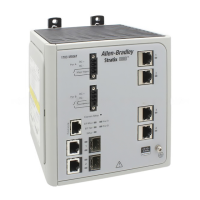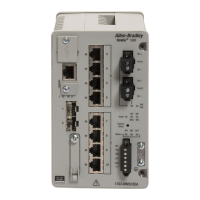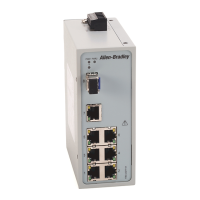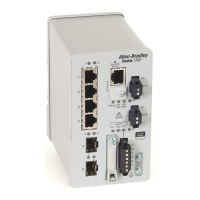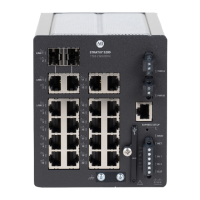78 Rockwell Automation Publication 1783-UM003G-EN-P - December 2012
Chapter 3 Manage the Switch via the Device Manager Web Interface
Synchronize the Switch
with Other Devices via PTP
The IEEE 1588 standard defines a protocol, called Precision Time Protocol, or
PTP, which enables precise synchronization of clocks in measurement and
control systems. The clocks communicate with each other over the EtherNet/IP
communication network. The PTP protocol enables heterogeneous systems that
include clocks of various inherent precision, resolution and stability to
synchronize. PTP generates a Master-Slave relationship among the clocks in the
system. All clocks ultimately derive their time from a clock selected as the
Grandmaster clock.
The switch supports these Synchronization Clock modes:
• End-to-End Transparent mode The switch transparently synchronizes all
slave clocks with the master clock connected to the switch.
The switch corrects the delay incurred by every packet passing through the
switch (referred to as residence time). This mode causes less jitter and error
accumulation than Boundary mode.
In End-to-End Transparent mode, all switch ports in the base are enabled.
• Boundary mode The switch becomes the parent clock to which the other
devices connected to the switch synchronize their internal clocks.
The switch and connected devices constantly exchange timing messages to
correct time skew caused by clock offsets and network delays.
This mode can eliminate the effects of latency fluctuations. Because jitter
and errors can accumulate in cascaded topologies, this mode should be
used only for networks with less than four layers of cascaded devices.
In Boundary mode, one or more switch ports can be PTP-enabled.
• Forward mode (default) Traffic is forwarded through the switch, while
being prioritized by QoS, but is not acted upon by the switch.
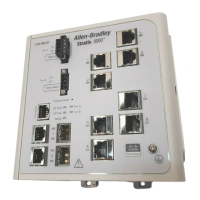
